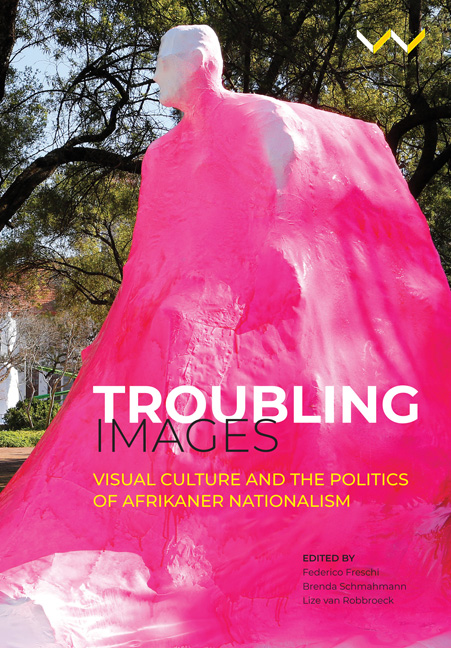Book contents
- Frontmatter
- Contents
- Acknowledgements
- List of Illustrations
- Troubling Images: An Introduction
- 1 The Trajectory and Dynamics of Afrikaner Nationalism in the Twentieth Century: An Overview
- One Assent and Dissent Through Fine Art and Architecture
- Two Sculptures on University Campuses
- Three Photography, Identity and Nationhood
- Four Deploying Mass Media and Popular Visual Culture
- Contributor Biographies
- Index
8 - Reframing David Goldblatt, Re-thinking Some Afrikaners
Published online by Cambridge University Press: 21 March 2020
- Frontmatter
- Contents
- Acknowledgements
- List of Illustrations
- Troubling Images: An Introduction
- 1 The Trajectory and Dynamics of Afrikaner Nationalism in the Twentieth Century: An Overview
- One Assent and Dissent Through Fine Art and Architecture
- Two Sculptures on University Campuses
- Three Photography, Identity and Nationhood
- Four Deploying Mass Media and Popular Visual Culture
- Contributor Biographies
- Index
Summary
Some Afrikaners Photographed was David Goldblatt's first major project, begun as early as 1962 and published in book form in 1975. In 2007, Goldblatt republished the collection with 20 additional photographs from the period and one omission, together with essays by Antjie Krog and Ivor Powell, as Some Afrikaners Revisited. In the introduction to the first edition, Goldblatt claimed not to have wanted to photograph the Afrikaner people, a project that he considered to be impossible, but rather ‘a few minutiae of Afrikaner life, with a few people’ (Goldblatt 1975, 7). However, far from a haphazard collection of photographs documenting the trivia of everyday life, Some Afrikaners Photographed may be seen as a construction of Afrikaner identity that reflected Goldblatt's position among South Africa's liberal Anglophile elite whom he addressed directly in the society magazines in which the first essays of the project appeared.
In the first part of this chapter, the history of Some Afrikaners is reconstructed by considering the archive of photographs begun in 1962 that was eventually edited into book form in 1975. In the second part, we look at the production and reception of the publication to show that Goldblatt's selection of images for the book, and his omissions, were guided by a search for a specific kind of perceived Afrikaner ‘authenticity’; in the process, however, he denied and silenced the complexity of identity, rather than ‘revealing’ hidden aspects, as critics have argued.
David Goldblatt created Some Afrikaners at the height of apartheid and Afrikaner nationalism, but it does not reproduce the narcissistic and heroic Afrikaner narratives propagated by the ideological state apparatuses of the time. Nevertheless, Goldblatt's project created an equally problematic representation of the Afrikaner in its failure to provide nuance and texture against the overwhelming ideological constructions of Afrikaner nationalism. Taking our cue from Amartya Sen's idea of the miniaturisation of identity as outlined in his Identity and Violence (2006), we propose that Goldblatt effectively reduced his subjects’ identities and situated them within narratives that were intended to create distance, rather than proximity.
PRODUCING THE ARCHIVE FOR SOME AFRIKANERS PHOTOGRAPHED
The earliest photographs in David Goldblatt's Some Afrikaners Photographed date from 1962 (Godby 2001).
- Type
- Chapter
- Information
- Troubling ImagesVisual Culture and the Politics of Afrikaner Nationalism, pp. 194 - 216Publisher: Wits University PressPrint publication year: 2020

